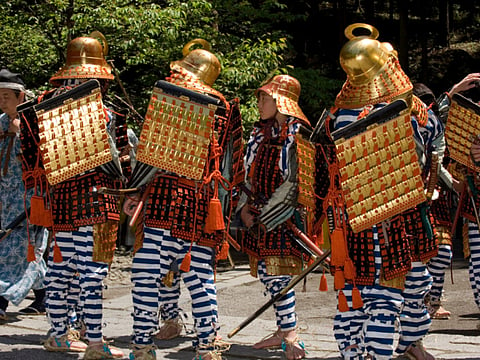7 festivals not to miss in Japan
The country hosts countless traditional festivals annually, from pensive to lively

Awa Odori
August 12-15; Tokushima, Shikoku island
Distinguished by irregular steps and energetic up-tempo rhythm, Awa (former name of Tokushima) Odori (dance) is a massive, city-wide dance party, attracting some 1.3 mil-lion visitors annually. Dating back to 1587, it is part of the Obon festival (a Buddhist celebration to honour the spirits of ancestors).
Nebuta Matsuri
August 2-7; Aomori, Honshu
Nebuta Matsuri features elegant, internally lit paper floats or nebutas — inspired by Japanese folklore and regional myths — that are paraded through the city to the accompaniment of taikos and dancers dressed in haneto, a traditional costume. The festival, dating back to the 9th century, is included in the list of Important Intangible Folk Cultural Properties of Japan.
Shunki Reitaisai
May 17-18; Nikko, Tochigi
Dedicated to one of the significant figures in Japanese history, Tokugawa Ieyasu (1542-1616), who was later deified and enshrined, this festival is held annually at Nikko Toshogu shrine, a World Heritage Site. Its highlight is the Hyakumono-Zoroe Sennin Gyoretsu, a procession by 1,000 men dressed in samurai costumes and armour. The pageant is preceded by Shinto priests on horseback and followed by lion dancers and musicians.
Yuki Matsuri
February 5-11; Sapporo, Hokkaido
Chill out at Yuki (snow) Matsuri, one of the country’s largest winter events, held at Odori Park, Tsudome and Susukino. Odori Park — which also hosts the International Snow Sculpture Contest — is the main site and features large snow and ice sculptures, as well as more than 100 smaller snow statues. Held since 1950, the festival attracts about two million visitors.
Nagaoka Matsuri
August 2-3; Nagaoka, Niigata
Feel the country’s spirit at one of Japan’s three largest fireworks (hanabi) shows, which began in 1946 as a memorial of the city air raid on August 1, 1945. Both nights end with a two-hour display of hanabi along the banks of the Shinanogawa River, featuring more than 20,000 fireworks. The event is famous for the Sanjakudama — one of the world’s biggest single fireworks, weighing 300kg and rising to 600m with a spread of 650m across the sky.
Hokkai Heso Matsuri
July 28-29; Furano, Hokkaido
Among the major summer festivals to look out for, Heso (belly button) Matsuri, held in downtown Furano, is packed with fun events and competitions. The festival highlight is the bizarre belly-art dance, where performers cavort about with large faces painted on their tummies. Inspired by the city’s central location (Furano is also known as Heso no Machi, or the Belly Button Town), the people came up with the amusing concept in 1969.
Danjiri Matsuri
September 19-20; Kishiwada, Osaka, Kansai
Started about 300 years ago, the danjiri (float) festival is one of the most thrilling traditional annual events in Japan. Centred in Kishiwada Castle, about 35 neighbourhood teams race their nearly four-tonne danjiri — hand-made, heavy-wheeled wooden floats with elaborate carvings and decorations to resemble small shrines or temples — through the narrow streets in a show of strength, endurance and celebration.
Sign up for the Daily Briefing
Get the latest news and updates straight to your inbox



